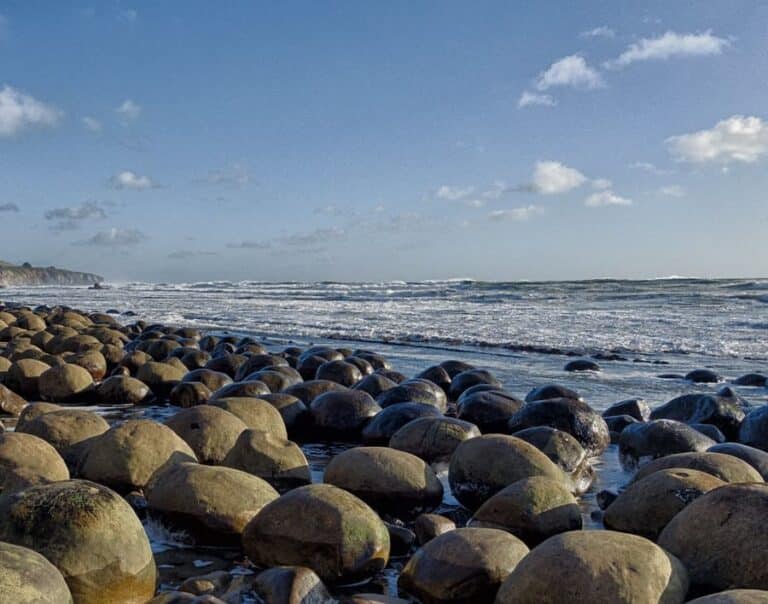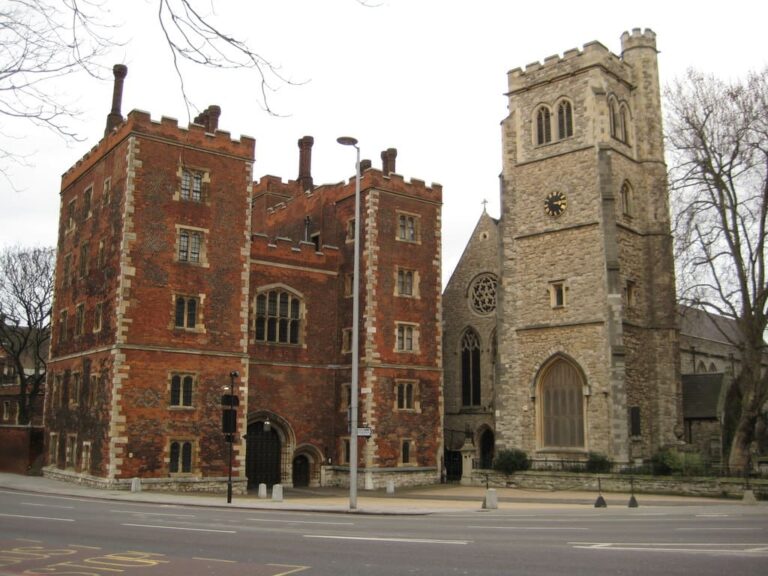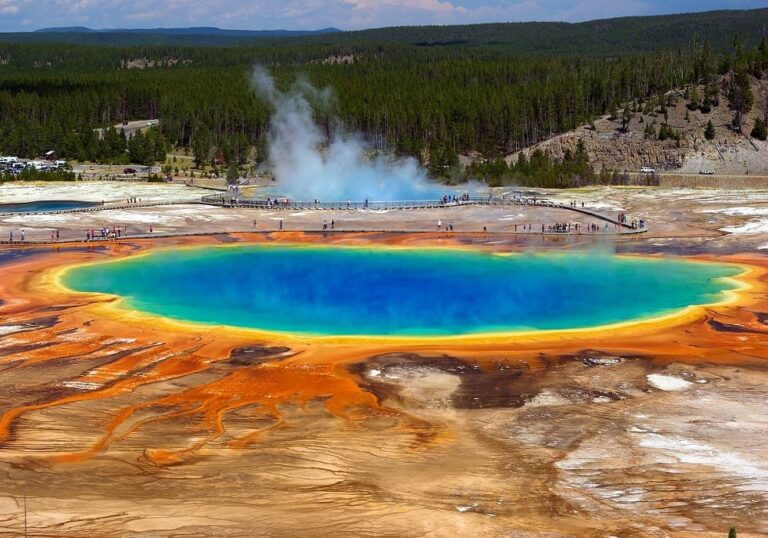20 Famous Landmarks in India You Must See
Last Updated on 1st October 2025 by admin
India is a nation that steals hearts with its ancient beauty, history, and architecture. Majestic forts, sacred temples, every part of this land is a story which links the past to the present. At World Famous Things, we love exploring the most iconic landmarks of India. In case you have plans to visit India or or simply are fascinated by reading about its beautiful places, here are 20 most famous landmarks in India you must visit at least once in your life.
1. Taj Mahal, Agra

A visit to India is never complete without a visit to the Taj Mahal which is one of the most famous landmarks in the world. This white marble masterpiece was constructed by the Mughal Emperor Shah Jahan in Agra, Uttar Pradesh and in the memory of his favorite wife Mumtaz Mahal. It started being built around 1631, and lasted over twenty years, finally being completed in 1653.
The Taj Mahal is located very beautifully on the Yamuna River banks, with green gardens and reflecting pools that reflect its beautiful image. Its ideal symmetry, intricate inlay design and Quranic texts make it an unforgettable experience. The marble changes in color with the light, being pink in the sunrise, and white in the middle of the day, and golden at sunset.
How wonderful is it that architecture can convey feeling! It is best to visit it in the morning because, at that time, there are fewer people around, and it is possible to feel its calm atmosphere. The Taj is not only a structure but a symbol of undying love and one of the most popular buildings in the world.
2. Hawa Mahal, Jaipur

Hawa Mahal, or “The Palace of Winds” is one of the most iconic symbols of Jaipur, Rajasthan. Construction of this pink sandstone palace was completed in 1799 by Maharaja Sawai Pratap Singh so that royal women can view the street life and festivities without being noticed.
The palace has a total of 953 small windows known as jharokhas through which fresh air moves in to the palace, keeping it cool even in the hot summer months at Jaipur. Its exterior is like a honeycomb and shines like the morning sun. The inside has small rooms and tiny corridors, which look amazingly out onto the busy city beneath.
When in front of Hawa Mahal, one gets a sense of time travelling to the royal period. Have you ever wondered what the queens must have thought of life when they stood in the back of those delicate screens, and looked over the city? It is one of the must visit places in Rajasthan and is a combination of the grace, culture and intelligent design.
3. Red Fort, Delhi

The Red Fort (Lal Qila), situated in the middle of Old Delhi, is a reminder of India’s Mughal heritage. The fort was constructed between 1638 and 1648 by Emperor Shah Jahan and was the primary home of Mughal rulers almost two centuries.
Its huge red sandstone walls are approximately 2.5 kilometers in length and include majestic halls, palaces, gardens, and mosques. You will also find the Diwan-i-Aam (Hall of Public Audience), Diwan-i-Khas (Hall of Private Audience), and Rang Mahal there, all of them demonstrate the artistry of Mughal architecture.
The fort still holds significance today, the Prime Minister of India hoists the national flag on its ramparts every Independence Day. When you pass through its gates you can nearly hear the echoes of royal processions and historic situations. It is a place that connects the majesty of the past and the pride of the present.
4. Golden Temple, Amritsar

The Golden Temple (Sri Harmandir Sahib) is a breathtaking structure in the holy city of Amritsar, Punjab. This temple was constructed in the late 16 th and early 17 th centuries as the most sacred shrine of Sikhism. The upper levels of the temple were adorned with gleaming gold leaf which is shining in the waters of the Amrit Sarovar (Pool of Nectar) around it.
The sound of hymns is calm, and the view of pilgrims walking naked down the marble causeway contribute to its spiritual effect. The Golden Temple is unique because it is open to everyone, regardless of their religion, culture, or background.
The langar (community kitchen) within the complex also provides free meals to thousands of visitors per day, which is a representation of equality and service. Have you ever known that kind of peace when words seem to be unnecessary? The Golden Temple provides it, a silent warm glow of remembrance of man and prayer.
5. Meenakshi Amman Temple, Madurai

Meenakshi Amman Temple is one of the most colorful and vibrant structures in India in the ancient city of Madurai, Tamil Nadu. The history of the temple is thousands of years old, but the current construction was mostly done in the 16th and 17th centuries by the Nayak rulers.
The temple is dedicated to Goddess Meenakshi (an avatar of Parvati) and her consort Lord Sundareswarar (Shiva), and its towering gopurams (gateways) feature thousands of brightly painted statues of gods, goddesses, and mythical creatures. The interior is filled with halls that have been carved with great detail such as the Thousand Pillar Hall which makes people feel amazed.
The temple is a field of lights, colors and devotion during festivals, particularly, the Meenakshi Tirukalyanam. The energy here is contagious. Imagine walking across halls full of chanting, and flowers and old art, all together at once? It is a memorable experience of spiritual beauty in South India.
6. Qutb Minar, Delhi

The Qutb Minar is one of the earliest monuments of the Indo-Islamic architecture to rise high in South Delhi, India. It was constructed in 1192 by Qutb-ud-din Aibak and finished by his successors in the 13th century. This red sandstone tower which is approximately 73 meters high was constructed as a way of commemorating Muslim rule following the defeat of the final Hindu kingdom in Delhi.
The minar is magnificently tapered at the top, which has delicately carved verses in Quran and ornamented balconies. It is surrounded by the Qutb Complex, comprising of the Quwwat-ul-Islam Mosque and the famous Iron Pillar, with its rust-resistant composition.
It is like strolling into history when walking around this place. Ever wondered how there could be such a fine workmanship 800 years ago? The Qutb Minar is a majestic example of medieval engineering and one of the most photographed places of Delhi even now.
7. Sun Temple, Konark

The Sun Temple of Konark, Odisha is one of the most amazing architectural marvels in India, and one of the famous landmarks in India. This UNESCO World Heritage is a construction built in the 13th century by king Narasimhadeva I of the Eastern Ganga dynasty in honor of the Sun God, Surya.
The temple was made in the shape of a huge stone chariot pulled by seven horses and twelve pairs of highly carved wheels to represent the movement of the sun in the heavens. Though various sections of the main building have since fallen down, other sculptures still show fantastic craftsmanship – of heavenly dancers, mythological figures.
The whole temple faces the eastern direction to receive the initial rays of the rising sun, which previously shone in the interior sanctum. When you are standing there at the dawn of the day you can nearly taste the olden-day piety in every stone. Would it not be amazing how art and science would meet so well centuries ago?
8. Mysore Palace, Mysuru

One of the most royal palaces in South India is the Mysore Palace or the Amba Vilas Palace. The present structure, located in Mysuru city, Karnataka, was constructed in 1897-1912 after the old wooden palace caught fire and was burned down.
It has a mixture of Hindu, Rajput, Muslim, and Gothic architecture and it produces a magnificent masterpiece of Indo-Saracenic. Within, the halls are decorated with rich ceilings, stained glass windows, elaborate work with wood, and bright murals. Durbar hall and Kalyana Mantapa (marriage hall) are especially magnificent.
On Sundays the palace is lit up with almost 100,000 bulbs and transforms it into a glowing fairytale palace. Suppose you were before that golden light? The Mysore Palace is an epitome of the royal legacy of India and it is a must visit location during a trip to Karnataka.
9. India Gate, New Delhi

The India Gate is a monumental war memorial standing tall in the middle of New Delhi in honor of more than 13,000 British Indian Army soldiers who died during world war I and the wars in Afghanistan. It is a 42-meter high arch, designed by Sir Edwin Lutyens and finished in 1931, a similarity to the Arc de Triomphe in Paris.
The walls of the building are engraved with names of lost lives of soldiers and act as a sobering reminder of death. Under the arch, there is the Amar Jawan Jyoti, also known as the eternity flame, dedicated to the memory of unknown soldiers.
India Gate is lit up at night by floodlights and families, couples, and tourists walk around enjoying the vibrant atmosphere. Have you ever known history lived in a simple, silent monument? India Gate does it very well, it is simultaneously patriotic and peaceful.
10. Gateway of India, Mumbai

The Gateway of India, which faces the Arabian Sea is the pride of Mumbai. It was constructed to honor the visit of the King George V and Queen Mary to India in 1911 and was finished in 1924. This magnificent basalt arch was designed in Indo-Saracenic style to serve as the official point of entry of British viceroys who came by sea.
Nowadays, it is one of the most popular sights in Mumbai, and a point of departure of boat tours to Elephanta Caves. When you are at the Gateway you can see ferries cross the harbor and pigeons flying around and snacks being sold by vendors.
It is particularly gorgeous during the sunset when the orange light and the sea wind make the scene miraculous. Have you ever known the soul of a city of a single look? The Gateway of India can provide that, a glimpse of the power and beauty of Mumbai.
11. Charminar, Hyderabad

The Charminar is a monument in the center of Hyderabad, Telangana, representing the rich history and culture of the city. This monument was erected in 1591 by Sultan Muhammad Quli Qutb Shah, as a monument to mark the establishment of Hyderabad.
Its name simply translates to Four Minarets, which are the four high towers which gently emerge in every corner of the square building. The upper floor is a mosque that has views of the lower busiest streets and ancient markets.
Laad Bazaar, surrounding the Charminar, is an upbeat street full of traders selling bangles, spices, perfumes and jewels. The combination of sounds, smells, and sights is the taste of Hyderabad. Did you ever stroll in an old bazaar where all corners are full of tales? That is the beauty of Charminar, history and everyday life come together beautifully here.
12. Agra Fort, Uttar Pradesh

The Agra Fort is another jewel that is located just a few kilometers away the Taj Mahal. The fort is the symbol of strength and skill of the Mughal Empire, being constructed by Emperor Akbar in the 16th century and redesigned by his grandson Shah Jahan.
It is made of huge red sandstone walls and is surrounded by palaces, mosques, halls and courtyards, which narrate the history of life in the imperial period. There are also the Diwan-i-Am (Hall of Public Audience), the Palace of Jahangir and the Khas Mahal, all of which are some of the most magnificent structures inside.
You can even see the Taj Mahal across the Yamuna river in some points in the fort–a bitter sight, because it was here that Shah Jahan was imprisoned by his own son, and is said to have looked at the Taj through his window in the last years of his life. Entering Agra Fort is like entering a living museum of the history of the Mughals, where every wall has experienced royal glory and tragedy.
13. City Palace, Udaipur

The City Palace of Udaipur, overlooking the serene Lake Pichola, is one of the symbols of royal grandeur of Rajasthan. Its construction started in 1559 under Maharana Udai Singh II and went on to take several centuries as rulers added their own personal touches.
It is technically a complex of multiple smaller palaces, courtyards, terraces, and gardens – each section of which reflects various epochs in the history of Mewar. Everything in the palace, including the carved balconies, the mirrored walls, and even the marble pavements, is a testimony to art and magnificence.
The interior museum displays royal artifacts, costumes, and paintings and the scenery of the upper terraces provides breathtaking panorama views of the Udaipur city and its glittering lakes. Have you ever seen a palace that is floating in the sunlight? The City Palace is precisely that, it is all elegant, romantic, and timeless.
14. Lotus Temple, Delhi

The Lotus Temple is a breathtaking masterpiece of architectural excellence, in spite of its modernism and spirituality. It is a Bahá’i House of Worship and it was opened in South Delhi in 1986 to allow everyone regardless of their faith and beliefs. Due to its beautiful structure it is one of the most famous buildings in the world.
It is shaped like a lotus flower -a symbol of peace and purity-completed of 27 white marble petals in nine sides. The hall is fully quiet and has neither idols nor religious paintings on the inside, so visitors can meditate and connect with the peace within.
The gardens and reflection pools around it provide a calm environment free of the noise of the city. The Lotus Temple gives you a perspective to think over, whether you believe in a religion or just like relaxing in serene surroundings. It is interesting how something this modern can be so spiritual, isn’t it?
15. Chittorgarh Fort, Rajasthan

The Chittorgarh Fort, which lies sprawled on a large hilltop in the state of Rajasthan, is one of the largest and oldest forts in India. It is an ancient city that was the capital of the Mewar Kingdom (7th century), and has experienced a lot of battles and heroism.
The fort covers a total of 700 acres and accommodates more than 65 historical buildings such as palaces, temples, water reservoirs, and two famous towers the Vijaya Stambha (Victory tower) and the Kirti Stambha (Tower of Fame). Vijaya Stambha, constructed by Rana Kumbha in 1448, praises victory over the Sultan of Malwa, and the Kirti Stambha praises Jain saints.
The Kalika Mata Temple and Samadhishvara Temple and Padmini Palace are also found within the fort complex with each having its own legends. The fort is known by its tales of the Rajput’s great courage and sacrifice especially the sacrifice of Rani Padmini. When you stand at its ramparts, looking down the plains below, and you can think of the courage and pride that would have filled these walls in days gone by.
16. Ellora Caves, Maharashtra

Next on the list is the amazing Ellora Caves, which is in Maharashtra just near Aurangabad. This UNESCO world heritage site is not just a complex of caves, but it is a living testimony to the ancient Indian artisanship and religious peace. Ellora was constructed in 600 to 1000 CE and it contains 34 rock-cut monasteries and temples representing three major religions of Hinduism, Buddhism, and Jainism.
The most astonishing in this category is the Kailasa Temple (Cave 16) which was made of a single rock. Imagine, the whole temple was hewn out of a mountain top down with hammers and chisels, thousands of years back! It is one of the most significant architectural projects in the world, the temple, which symbolizes the mountain Kailash, the residence of Lord Shiva.
This place is one of the most visited landmarks in India, exploring Ellora feels almost unreal – there are old-time carvings, pillars, and statues narrating mythological tales. Ellora Caves will leave you speechless, in case you love history, spirituality, or architecture, making them must visited landmarks in India.
17. Statue of Unity, Gujarat

The Statue of Unity, the tallest statue in the world built near the Sardar Sarovar Dam in Kevadia, Gujarat. This statue is incredible in height, being 182 meters (597 feet) long, and is dedicated to Sardar Vallabhbhai Patel, the Iron Man of India who was instrumental in the integration of the country following independence. The statue was opened in 2018 and is rapidly gaining popularity among the famous landmarks in India .
It was designed by sculptor Ram V. Sutar, and took 4 years and thousands of workers to complete. The statue is located on the Narmada River and enjoys the picturesque hills and gardens. Tourists have the opportunity to ride on a high speed elevator into the viewing gallery, which is 153 meters above the ground giving them a breathtaking view of the dam and the surrounding landscape.
Below is also a museum and exhibition hall illustrating the life and contribution of Sardar patel to India. This is the best place to visit in case you want to see how India honors its heroes today. It is more than a monument, it is a unity, power, and national pride.
18. Ajanta Caves, Maharashtra

The Ajanta Caves are another ancient treasure just a very short distance away in Ellora. Ajanta, a cluster of 30 rock-cut Buddhist caves, which date back to around 2nd century BCE, is famous with its spectacular paintings and sculptures. Buddhist monks used these caves as monasteries and prayer halls.
These walls are adorned with murals describing life of Lord Buddha, and scenes of Jataka tales. Even after thousands of years, the colors still appear to be fresh and alive. It is surprising how ancient artists could achieve such perfection using modern tools, right?
The artwork of Ajanta has not only spirituality but also the richness of cultures of ancient India. The tourists may choose to stroll calmly through the caves and experience a sense of peace and wonder. It is a must visit site to every person who wishes to visit the timeless art and devotion of India.
19. Amber Fort & Palace, Jaipur

Amber Fort and Palace is one of the greatest architectural masterworks of Rajasthan, located only 11 km away from Jaipur. This great fort, constructed in 1592 by Raja Man Singh I, is a giant structure on a hill overlooking Maota lake to form a perfect show that draws tourists all over the world.
The fort is a good combination of Hindu and Mughal architecture constructed of red sandstone and white marble. The interior part is the Sheesh Mahal (Mirror Palace), and it is a marvel, every inch of the wall being encircled with small mirrors that are gleaming with the light. You will also come across gates painted beautifully, spacious courtyards and royal halls where kings and queens of Jaipur once sat.
When we walk through the fort it is like we have gone back in time to the royal period. Have you ever wondered how the life of the Rajput rulers must have been in the past centuries? You get that glimpse by visiting Amber Fort. The evening light and sound show is an additional attraction, narrating the history of the glorious past of the fort in an interesting manner.
20. Gwalior Fort, Madhya Pradesh

Last but definitely not least, the Gwalior Fort is a great and ancient fort in India that stands high on the sandstone hill. This giant fort has seen numerous battles and royal events and is also known as the “Gibraltar of India”. Suraj Sen initially constructed it in the 8th century and over time it was extended by different rulers.
The fort complex consists of stunning palaces, temples, water tanks. The Man Singh Palace, with its vivid blue ceramic tiles, is especially beautiful. Within it, there are secret passages, beautiful balconies, and walls adorned with complex carvings.
The city of Gwalior is stunningly visible at the top of the fort. The complex of the fort has the Saas Bahu Temple, the Gujari Mahal, and the Teli Ka Mandir that are also worth visiting. The walk through Gwalior Fort is like having a stroll through pages of Indian history – Rajput, Mughal, Maratha, British, all came and left their mark here.
These famous landmarks in India are not only historic sites, but also narrators. These locations reveal the variety and richness of Indian culture in the quiet spirituality of the Golden Temple to the romanticism of the Taj Mahal, and the royal residences of Rajasthan to the holy temples of the South. Which of these famous landmarks in India would you most like to visit? You will find India a destination that will leave you wondering, discovering and relating, no matter whether you like the serenity of temples, the power of forts or the charm of palaces.






